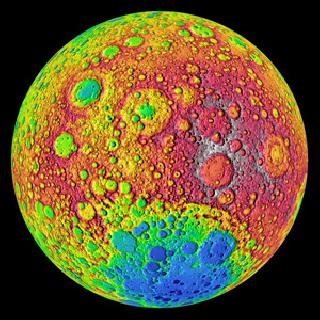
This image of the lunar farside from NASA's Lunar Reconnaissance Orbiter shows the moon's topography with the highest elevations (above 20,000 feet) in red and the lowest areas in blue. Photo by: NASA/Goddard.
WASHINGTON (BNS): A new study has suggested that the bulge of elevated topography on the far side of the moon could be the result of tidal forces acting early in the moon's history when its solid outer crust floated on an ocean of liquid rock.
Ian Garrick-Bethell, an assistant professor of Earth and planetary sciences at UC Santa Cruz, found that the shape of the moon's bulge can be described by a surprisingly simple mathematical function.
"What's interesting is that the form of the mathematical function implies that tides had something to do with the formation of that terrain," Garrick-Bethell, who is the first author of a paper on the new findings, was quoted as saying in a news release by the University of California, Santa Cruz.
The paper described a process for formation of the lunar highlands that involves tidal heating of the moon's crust about 4.4 billion years ago. At that time, not long after the moon's formation, the crust was decoupled from the mantle below it by an intervening ocean
of magma.
As a result, the gravitational pull of the Earth caused tidal flexing and heating of the crust. At the Polar Regions, where the flexing and heating was greatest, the crust became thinner, while the thickest crust would have formed in the regions in line with the Earth.
This process still does not explain why the bulge is now found only on the farside of the moon.
"You would expect to see a bulge on both sides, because tides have a symmetrical effect. It may be that volcanic activity or other geological processes over the past 4.4 billion years have changed the expression of the bulge on the nearside," Garrick-Bethell said.
A map of crustal thickness based on the gravity data showed that an especially thick region of the moon's crust underlies the lunar farside highlands. The variations in crustal thickness on the moon are similar to effects seen on Jupiter's moon Europa, which has a shell of ice over an ocean of liquid water. Nimmo has studied the effects of tidal heating on the structure of Europa, and the researchers applied the same analytical approach to the moon.
"Europa is a completely different satellite from our moon, but it gave us the idea to look at the process of tidal flexing of the crust over a liquid ocean," Garrick-Bethell further added, as per the release.
The mathematical function that describes the shape of the moon's bulge can account for about one-fourth of the moon's shape, he said. Although mysteries still remain, such as what made the nearside so different, the new study provides a mathematical framework for further investigations into the shape of the moon.
The paper's coauthors include Francis Nimmo, associate professor of Earth and planetary sciences at UCSC, and Mark Wieczorek, a planetary geophysicist at the Institut de Physique du Globe in Paris. The researchers analyzed topographical data from NASA's Lunar Reconnaissance Orbiter and gravitational data from Japan's Kaguya orbiter.
 Previous Article
Previous Article Next Article
Next Article













The Indian Air Force, in its flight trials evaluation report submitted before the Defence Ministry l..
view articleAn insight into the Medium Multi-Role Combat Aircraft competition...
view articleSky enthusiasts can now spot the International Space Station (ISS) commanded by Indian-American astr..
view article